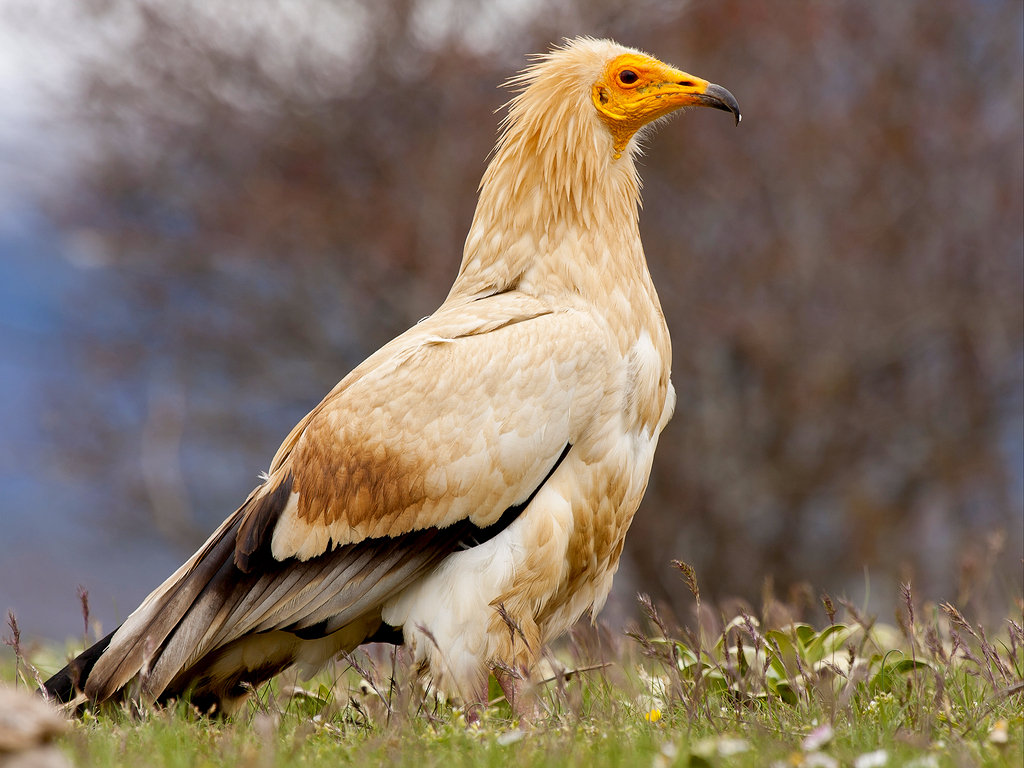- Home
- Conservancy
- Egyptian vulture
Description
The Egyptian vulture (Neophron percnopterus), also called the white scavenger vulture or pharaoh's chicken, is a small Old World vulture and the only member of the genus Neophron. It is widely distributed; the Egyptian vulture is found from southwestern Europe and northern Africa to India. The contrasting underwing pattern and wedge-shaped tail make it distinctive in flight as it soars in thermals during the warmer parts of the day. Egyptian vultures feed mainly on carrion but are opportunistic and will prey on small mammals, birds, and reptiles.
They also feed on the eggs of other birds, breaking larger ones by tossing a large pebble onto them. The use of tools is rare in birds and apart from the use of a pebble as a hammer, Egyptian vultures also use twigs to roll up wool for use in their nest. Egyptian vultures that breed in the temperate regions migrate south in winter while tropical populations are relatively sedentary. Populations of this species have declined in the 20th century and some island populations are endangered by hunting, accidental poisoning, and collision with power lines.
The adult's plumage is white, with black flight feathers in the wings. Wild birds usually appear soiled with a rusty or brown shade to the white plumage, derived from mud or iron-rich soil. Captive specimens without access to soil have clean white plumage. The bill is slender and long, and the tip of the upper mandible is hooked. The nostril is an elongated horizontal slit. The neck feathers are long and form a hackle. The wings are pointed, with the third primary being the longest; the tail is wedge shaped. The legs are pink in adults and grey in juveniles.The claws are long and straight, and the third and fourth toes are slightly webbed at the base.
The bill is black in the nominate subspecies but pale or yellowish in adults of the smaller Indian ginginianus. Rasmussen and Anderton (2005) suggest that this variation may need further study, particularly due to the intermediate black-tipped bill described in rubripersonatus.[9][22] The facial skin is yellow and unfeathered down to the throat. The sexes are indistinguishable in plumage but breeding males have a deeper orange facial skin colour than females.[19] Females average slightly larger and are about 10–15% heavier than males. Young birds are blackish or chocolate brown with black and white patches.[23] The adult plumage is attained only after about five years.
The adult Egyptian vulture measures 47–65 centimetres (19–26 in) from the point of the beak to the extremity of the tail feathers. In the smaller N. p. ginginianus males are about 47–52 centimetres (19–20 in) long while females are 52–55.5 centimetres (20.5–21.9 in) long. The wingspan is about 2.7 times the body length. Birds from Spain weigh about 1.9 kilograms (4.2 lb) while birds of the Canary Island subspecies majorensis, representing a case of island gigantism, are heavier with an average weight of 2.4 kilograms (5.3 lb).
Fun Facts
he Egyptian vulture is usually seen singly or in pairs, soaring in thermals along with other scavengers and birds of prey, or perched on the ground or atop a building. On the ground, they walk with a waddling gait. They feed on a range of food, including mammal faeces (including those of humans , insects in dung, carrion, vegetable matter, and sometimes small animals. When it joins other vulture species at a dead animal, it tends to stay on the periphery and waits until the larger species leave. Wild rabbits (Oryctolagus cuniculus) form a significant part of the diet of Spanish vultures. Studies suggest that they feed on ungulate faeces to obtain carotenoid pigments responsible for their bright yellow and orange facial skin.
The ability to assimilate carotenoid pigments may serve as a reliable signal of fitness. Egyptian vultures are mostly silent but make high-pitched mewing or hissing notes at the nest and screeching noises when squabbling at a carcass. Young birds have been heard making a hissing croak in flight. They also hiss or growl when threatened or angry. Egyptian vultures roost communally on large trees, buildings or on cliffs. Roost sites are usually chosen close to a dump site or other suitable foraging area. In Spain, summer roosts are formed mainly by immature birds. The favourite roost trees tended to be large dead pines. The number of adults at the roost increases towards June. It is thought that breeding adults may be able to forage more efficiently by joining the roost and following others to the best feeding areas. Breeding birds that failed to raise young may also join the non-breeding birds at the roost during June.
